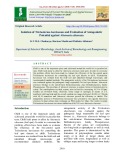
Dual culture
-
Ebook Dual diagnosis nursing: Part 2 includes content: Models of care and dual diagnosis, relapse prevention in dual diagnosis, motivational interviewing, dual diagnosis - interventions with carers,… and other contents.
 152p
152p  longtimenosee03
longtimenosee03
 01-02-2024
01-02-2024
 3
3
 0
0
 Download
Download
-
This study aimed to investigate the antagonistic effect of three strains of the genus Bacillus on toxigenic fungi contaminating food commodities, with emphasis on two ochratoxigenic isolates (A. ochraceus, A. westerdijkiae) and two aflatoxigenic isolates (A. flavus and A. parasiticus). In vitro studies were carried out using two different methods for cultivation tested bacilli with fungal isolates – coincubation and dual culture method.
 7p
7p  mudbound
mudbound
 10-12-2021
10-12-2021
 8
8
 1
1
 Download
Download
-
We aimed to assess the effects of bradykinin (BK) on the proliferation, apoptosis, and cycle of glomerular mesangial cells via the transforming growth factor-β 1 (TGF-β1)/Smad signaling pathway. Rat glomerular mesangial cells, HBZY-1, were divided into normal group (untreated), model group (5 ng/L TGF-β1), BK group (5 ng/L TGF-β1 + 1 ng/L BK), and inhibitor group [5 ng/L TGF-β1 + 1 ng/L LY2109761 (TGF-β1-specific inhibitor)].
 9p
9p  thiencuuchu
thiencuuchu
 27-11-2021
27-11-2021
 14
14
 2
2
 Download
Download
-
Tomato (Lycopersicon esculentum Mill.) is the most popular vegetable grown across the world. Wilt disease caused by the fungus Fusarium oxysporum f.sp. lycopersici is one of the most devastating and destructive disease of tomato, resulting in significant yield loss. The pathogen causing wilt disease in tomato was isolated and confirmed its pathogenicity in glasshouse experiment. The effect of fungal biocontrol agent Chaetomium spp. was studied against fusarium wilt pathogen under in vitro condition. Among the Chaetomium spp., Ch. cochiloides showed highest inhibition percentage of 64.
 11p
11p  caygaocaolon11
caygaocaolon11
 21-04-2021
21-04-2021
 12
12
 1
1
 Download
Download
-
Wilt caused by Fusarium oxysporum f. sp. ricini poses a major problem in all the castor growing areas of the country. Since the soil borne disease can be effectively controlled by biocontrol agents, the present study was conducted to know the antagonistic activity of different bioagents in vitro at department of Plant Pathology, College of Agriculture, UAS, GKVK, Bengaluru during 2019-20.
 8p
8p  caygaocaolon11
caygaocaolon11
 21-04-2021
21-04-2021
 19
19
 1
1
 Download
Download
-
Stem and root rot and wilt diseases of sesame incited by Macrophomina phaseolina and Fusarium oxysporum f. sp. sesami respectively were serious biotic constraints for sesame production. Investigations have been formulated on dual culture technique, cut stem inoculation experiment and soil inoculation experiment in order to assess the interaction and combined effect of Macrophomina phaseolina and Fusarium oxysporum f.sp. sesami. Macrophomina did not showed any antagonistic effect towards Fusarium and vice versa in dual culture experiment.
 5p
5p  cothumenhmong9
cothumenhmong9
 18-01-2021
18-01-2021
 10
10
 2
2
 Download
Download
-
Tissue engineering is emerging as a modern medicine fascination towards the establishment of human tissue banks; yet, these approaches typically involve cultures of only one type of cell and, therefore, do not recapitulate the native tissue physiology in toto. Co-culture models, comprised of different cell types, can potentially create the next level of complexity. However, conventional approaches involving multiple cell types and cell culture inserts do have limitations.
 11p
11p  larachdumlanat129
larachdumlanat129
 14-01-2021
14-01-2021
 22
22
 2
2
 Download
Download
-
The antagonistic efficacy of five different bio-agents viz., Trichoderma viride, Trichoderma harzianum, Trichoderma longibrachiatum, Pseudomonas fluorescens and Bacillus subtilis was tested against 25 isolates of Macrophomina phaseolina causing castor root rot by dual culture techniques under in vitro conditions.
 5p
5p  trinhthamhodang9
trinhthamhodang9
 16-12-2020
16-12-2020
 11
11
 2
2
 Download
Download
-
In vitro evaluation of three contact and five systemic and two combination was carried out under laboratory condition in 2018-19 at Department of Plant Pathology, College of Horticulture, Mysuru by using Potato Dextrose Agar medium (PDA) as basal medium and six biocontrol agents were evaluated through dual culture technique. The result revealed that, there was significant difference among the fungicides in inhibiting the radial growth of the A. solani.
 7p
7p  trinhthamhodang1216
trinhthamhodang1216
 19-11-2020
19-11-2020
 13
13
 1
1
 Download
Download
-
Present experiment was conducted to evaluate the antifungal efficacy of different biocontrol agents against Pythium aphanidermatum. The six isolates of Trichoderma viz., Trichoderma isolate1, Trichoderma isolate 2, Trichoderma isolate 3, Trichoderma isolate 4, Trichoderma isolate 5 and Trichoderma isolate 6 were studied for their antagonistic nature against P. aphanidermatum in vitrousing dual culture method.
 6p
6p  caygaocaolon7
caygaocaolon7
 18-09-2020
18-09-2020
 14
14
 0
0
 Download
Download
-
Early blight of potato caused by Alternaria alternata is one of the major diseases causing considerable yield loss. Efficacy of bio-agents was studied and revealed the all four Trichoderma species significantly reduced the mycelial growth of the pathogen over the control by dual culture method. Significantly maximum inhibition of mycelial growth was obtained with T. viride (57.08%) followed by T. azospirillum (50.00%), T. harzianum (43.26%) and T. virens (37.08%) of the pathogen after 48 hours of incubation. In present study, T. viride was observed more inhibitory against A. alternata...
 6p
6p  kethamoi7
kethamoi7
 26-08-2020
26-08-2020
 11
11
 2
2
 Download
Download
-
Attachment of soil bacteria to plant cells is supposedly the very early step required in plant–microbe interactions. Attachment also is an initial step for the formation of microbial biofilms on plant roots. For the rhizobia–legume symbiosis, various mechanisms and diverse surface molecules of both partners have been proposed to mediate in this process. A biofilm is an aggregate of microorganisms in which cells are stuck to each other and/or to biotic/abiotic surface.
 11p
11p  angicungduoc6
angicungduoc6
 20-07-2020
20-07-2020
 16
16
 1
1
 Download
Download
-
To manage the disease an investigation at the Department of Plant Pathology, SHIATS-DU, Allahabad was carried out to evaluate the effect of bio-agents viz. Trichoderma viride @ 2%, Pseudomonas fluorescens @ 2%, T. harzianum @ 2%, botanical viz. neem leaf extract @ 5%, neem oil @ 5% and fungicide viz. carbendazim @ 0.2% against R. solani under invitro condition by dual culture and poisoned food technique. All the bioagents and botanical were evaluated singly. All the treatments significantly inhibited the mycelial growth of R. solani as compared to untreated check.
 5p
5p  chauchaungayxua6
chauchaungayxua6
 26-06-2020
26-06-2020
 11
11
 2
2
 Download
Download
-
Foot rot of tomato is an important disease which causes severe loss in tomato production. The present study was carried out to evaluate five bioagents and six fungicides against Sclerotium rolfsii. Among the five antagonists tested the maximum inhibition was observed in Trichoderma virens (67%) and contrarily, no inhibition was observed in Bacillus subtilis. Six fungicides viz., carbendazim, captan, tebuconozole, copper oxychloride, hexaconozole and Tebuconazole +Trifloxytrobin at different concentrations (50, 100, 150, 200, 250 and 500 ppm), were tested.
 8p
8p  chauchaungayxua6
chauchaungayxua6
 26-06-2020
26-06-2020
 16
16
 2
2
 Download
Download
-
The present study is on the isolation, characterization and screening of endophytic bacterium i.e., Gluconacetobacter diazotrophicus which was isolated from the tissues of surface sterilized roots of four different crops viz., sugarcane, maize, pineapple and carrot. The morphological and biochemical tests permitted characterization of Gluconacetobacter diazotrophicus isolates.
 10p
10p  chauchaungayxua6
chauchaungayxua6
 26-06-2020
26-06-2020
 17
17
 1
1
 Download
Download
-
In the present study, 25 soil samples were collected from the different location of U.P and M.H. and 17 Trichoderma isolates were obtained belonging to three different species T. harzianum, T. viride and T. koningi. All the obtained isolates were studied microscopically for their species level identification. Morphological characterization of all the isolates was done. All the isolates were screened against Fusarium oxysporum f. sp. lycopersci for their efficacy through dual culture technique. Highest mycelium inhibition was recorded with SVPU-Thar7, (81.
 8p
8p  nguaconbaynhay6
nguaconbaynhay6
 24-06-2020
24-06-2020
 9
9
 1
1
 Download
Download
-
Early blight is potentially destructive disease in tomato occurring on the oldest leaves as small, brownish which are due to foliar blight disease and it was caused by a foliar fungal pathogen Alternaria solani. The disease causes considerable yield as well as post-harvest losses. A. solani produced blackish, fluffy mycelium with septate, beaked conidia on PDA Eight plant extracts and four biocontrol agents were evaluated following poison food technique and dual culture.
 6p
6p  quenchua6
quenchua6
 15-06-2020
15-06-2020
 8
8
 2
2
 Download
Download
-
Effect of eight antagonists viz., Trichoderma atroviride, T. harzianum, T. virens, T. fasciculatum, T. asperellum, T. viride, Pseudomonas fluorescens and Bacillus subtilis were studied for their antagonism against Macrophomina phaseolina by dual culture method and six fungicides viz. Azoxystrobin 23 SC, Carbendazim (12%) + Mancozeb (63%) 75 WP, Carbendazim (25%) + Mancozeb (50%) 75 WS were evaluated at two different concentrations (500 ppm and 1000 ppm) by poisoned food technique against the same pathogen.
 7p
7p  quenchua6
quenchua6
 15-06-2020
15-06-2020
 9
9
 2
2
 Download
Download
-
Biological control is known to be effective eco-friendly method for the management of crop diseases (Cook and Baker, 1983). Rhizosphere antagonists were isolated from healthy rhizosphere soil samples of chilli collected from major chilli growing areas of Andhra Pradesh. A total of 20 rhizosphere microbes were isolated. Out of which (eight fungal antagonists, ten bacterial antagonists and two fluorescent Pseudomonads) were found to exhibit antagonism against chilli wilt pathogen. On further in vitro evaluation, nine isolates including four fungi, four bacteria and one pseudomonas sp.
 6p
6p  quenchua6
quenchua6
 15-06-2020
15-06-2020
 9
9
 2
2
 Download
Download
-
Chilli is one of the important spices and cultivated around the world for its peculiar hot taste. Chilli leafs prone to affect by Alternaria alternata (leaf spot). In order to overcome this problem, efforts have been made to evaluate the efficiency of the bio-control agent Trichoderma harzianum for controlling the leaf spot disease in chilli. Trichoderma harzianum was isolated from the field soil and identified through microscopic and recommended standard methods.
 9p
9p  angicungduoc5
angicungduoc5
 12-06-2020
12-06-2020
 14
14
 2
2
 Download
Download
CHỦ ĐỀ BẠN MUỐN TÌM











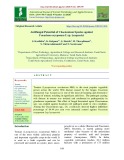
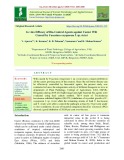
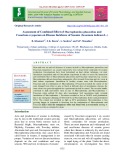
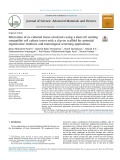
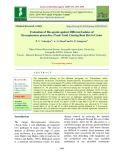
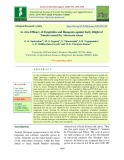

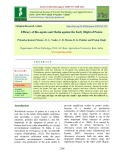

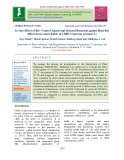
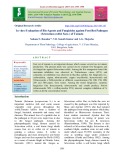

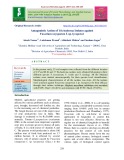
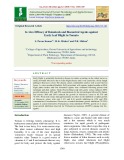
![Evaluation of antagonistic potential of biocontrol agents against Macrophomina phaseolina (tassi) goid. causing stem and root rot of sesame [Sesamum Indicum l.] under in vitro and in vivo Evaluation of antagonistic potential of biocontrol agents against Macrophomina phaseolina (tassi) goid. causing stem and root rot of sesame [Sesamum Indicum l.] under in vitro and in vivo](https://tailieu.vn/image/document/thumbnail/2020/20200615/quenchua6/135x160/7171592231791.jpg)

